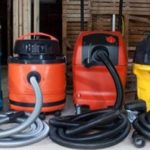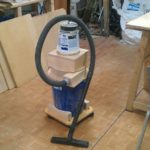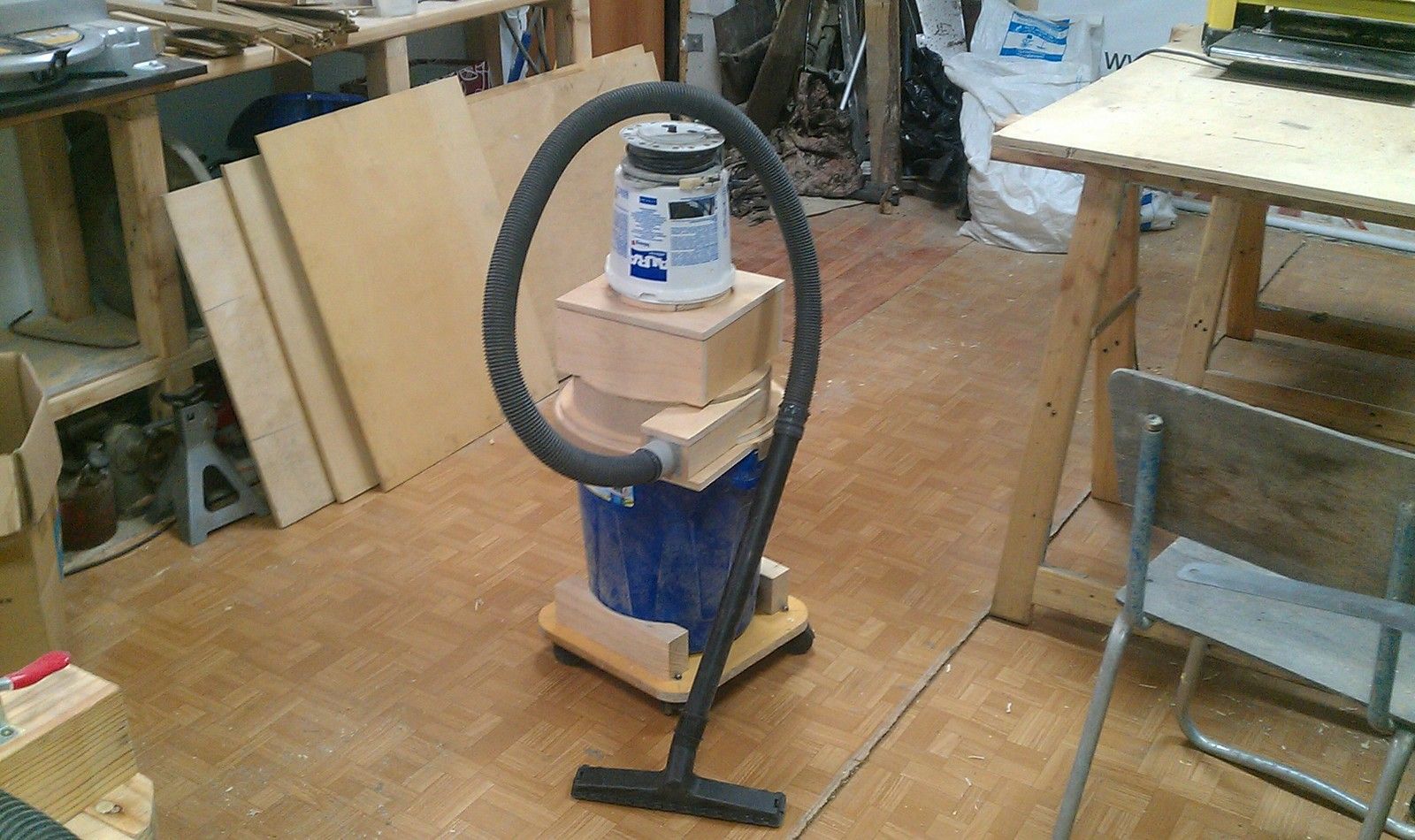DIY construction vacuum cleaner
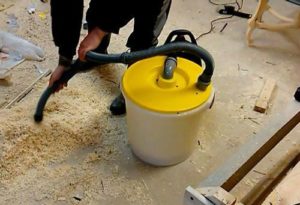 During construction and repair work, a large amount of waste is generated associated with the processing of certain materials. Construction waste combines both small dust particles and large fragments, so an attempt to use a regular household vacuum cleaner, at best, ends in rapid clogging of the internal filters, and in the worst case, failure of the device itself.
During construction and repair work, a large amount of waste is generated associated with the processing of certain materials. Construction waste combines both small dust particles and large fragments, so an attempt to use a regular household vacuum cleaner, at best, ends in rapid clogging of the internal filters, and in the worst case, failure of the device itself.
For those who are professionally involved in repairs, the only correct way out of the situation is to purchase a high-quality industrial vacuum cleaner designed for cleaning construction waste. If the repair is local in nature, the costs of such expensive equipment for rare use are unjustified. In this case, you can upgrade your household vacuum cleaner or make it yourself, which is what will be discussed in this article.
The content of the article
How to make a construction vacuum cleaner
It’s quite possible to make a homemade construction vacuum cleaner yourself. To make a device that captures fine construction dust with the ability to clean the air, you can use an old household vacuum cleaner as a base. To collect large fragments of construction waste or cement dust, you can assemble a structure by making it from available materials.
From a household vacuum cleaner
To upgrade the version of a vacuum cleaner from a regular one to a construction one with a water filter, you need to take the old model of the device. In addition, you will need:
- plastic bottle 5–6 liters;
- old aluminum pan;
- a small piece of corrugated tube;
- metal plate with a pipe;
- tools: soldering iron, construction knife, screwdriver.
The first step is to replace the internal filters. Instead of thick paper materials, you need to install foam rubber sections cut to size at the input of the device.
The filtration system at the outlet of the device will be replaced. The standard filter must be removed. In its place, a metal plate is attached with self-tapping screws, cut to the size of the seat, with a welded nozzle for the hose and a through hole at the place of its attachment.
A plastic bottle is supposed to be used as a reservoir for the water filter. To add strength to the structure, it is necessary to select a solid container, which will also be fixed to the vacuum cleaner body from the back using self-tapping screws.
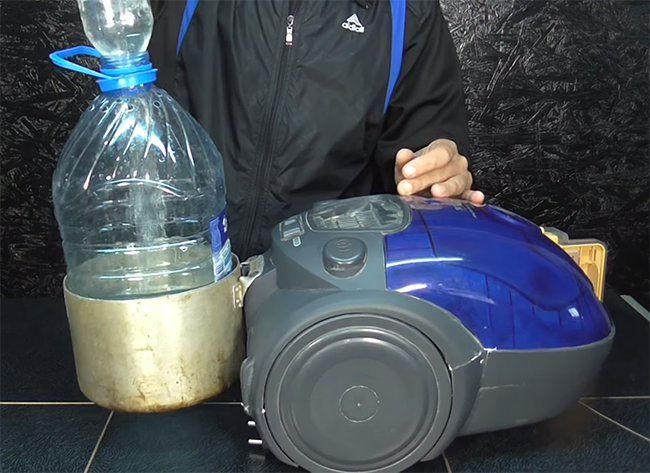
The bottle should fit tightly inside this container. For these purposes, you can use an old aluminum pan of suitable diameter. To lighten the body, you can cut off the bottom, leaving a small border a couple of centimeters wide to hold the plastic bottle. Also, a handle with two holes is attached to one side of the metal utensil, and the third is drilled into its body at the bottom.
The holes should form an equilateral triangle, the height of which will touch the body of the pan and the vacuum cleaner. Through them, the bottle filter is attached to the main unit with self-tapping screws.In the upper part of the tank, at the narrowing point of the bottle, using a soldering iron, holes are made through which the purified air will come out.
You need to pour half a liter of clean water into the tank. To connect the filter to the outlet of the vacuum cleaner, it is necessary to cut a plastic corrugated hose of suitable length and diameter, one end of which is tightly pulled onto the prepared metal pipe on the plate, installed instead of the standard air purification filter.
The free part of the plastic corrugation is lowered through the neck of the bottle to the very bottom so that the escaping air goes straight into the water.
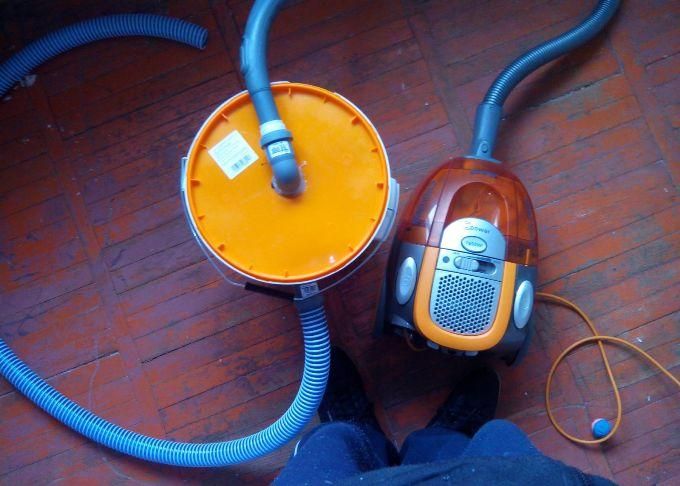
Having installed a standard waste container, you can turn on the device and begin testing. It will show that the power of the vacuum cleaner has noticeably increased and has stopped rapidly falling during operation, as it was before, and the quality of cleaning has improved significantly - now the smallest dust particles do not leave the dust collector, but are captured in the water filter at the outlet.
From improvised means
The second approach is to make a vacuum cleaner entirely with your own hands. As an example, consider a small device suitable for assembling large fragments of construction waste. For this you will need:
- plastic bottles of different shapes - 3 pcs.;
- impeller from a powerful computer cooler;
- hot glue;
- electric motor and 12 V power supply;
- plastic corrugation;
- tools: hot glue gun, knife, soldering iron.
The sequence of actions is as follows.
To begin, disassemble the cooler, remove the impeller and attach it to the motor shaft so that it drives air towards itself. Take plastic bottles of the same diameter with a round top.Cut off the bottom of one of the bottles at a distance of 5–10 cm.
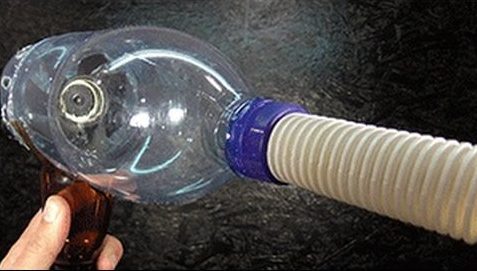
The motor housing will be fixed in it. The second bottle should be cut at a distance of 15–20 cm from the bottom. A hole is made in the bottom of both blanks for the assembled compressor. Its propeller is placed inside a long bottle blank, and the cylindrical motor housing must pass right through the bottom.
The joint is treated with hot melt adhesive for a strong connection. The remaining plastic blank is placed on top of the cylinder, which, with its cut-off part, should slightly extend to the bottom of the long bottle product according to the matryoshka principle.
Thus, the electric motor was fixed between two cylindrical fragments of bottles. All formed connection lines between parts must be glued.
The top of one of the used bottles should have a narrowing shape approximately in the middle of the height. It must be cut so that it fits inside the structure described above. The vacuum cleaner body is almost ready. All that remains is to make a coarse filter for construction waste.
To do this, you need to take a bottle of a different shape. with long conical neck. It must be cut at a distance of 10–15 cm from the cork thread. Narrow holes are made in the workpiece using a soldering iron. They will allow air flow to pass through, and the top of the bottle itself will hold trapped fragments of construction debris. Holes are also made in the lid, after which it is screwed into place.
In order for air to leave the body of an improvised vacuum cleaner, it is necessary to make slots with a soldering iron in the lower part of the body in which the motor is fixed.
Now you can carry out the final assembly – insert the filter into the upper part of the housing. The necks of the bottles should be aligned. Now align the top and bottom of the device. The work is almost complete, all that remains is to attach the handle by cutting it out of the unused part of the bottle and placing it on hot glue, connect it to the power supply and attach a piece of corrugated pipe to capture debris.
Construction vacuum cleaners with aqua filter and cyclones
There are 2 types of construction vacuum cleaners.
Devices with aquafilter suck in debris that passes through the water barrier with the air flow. The advantages of such devices – ideal air purification from the smallest particles. The manufacturing principle is described in the section above.
Cyclone models designed for cleaning heavy large fragments that a vacuum cleaner with an aqua filter cannot remove. Minuses – they are unable to efficiently filter fine construction dust.
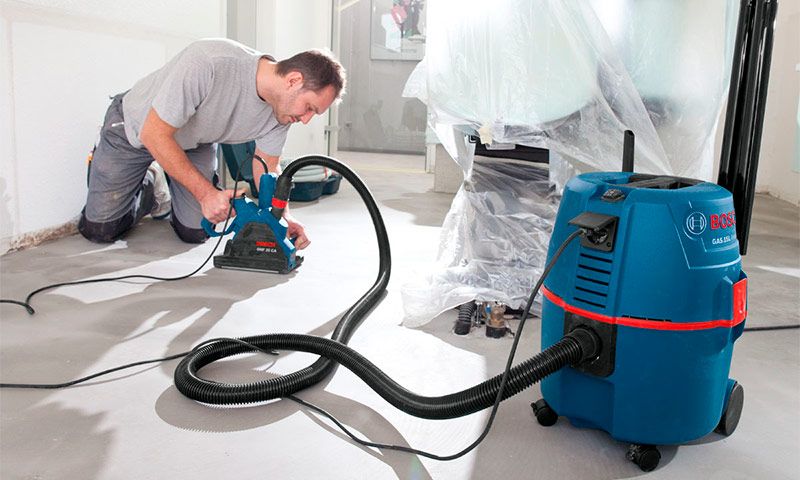
The principle of self-production is also similar to that described above. The difference is that instead of a water tank, a separator is assembled, which causes large debris to fall to the bottom of the housing under its own weight. Such a separator can be easily made from plumbing fittings. The principles of connecting the cleaning unit to the main part of the vacuum cleaner are identical to those described earlier.


